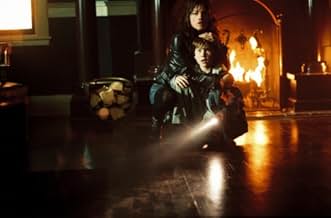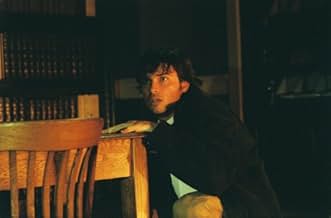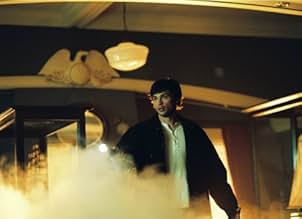AVALIAÇÃO DA IMDb
3,7/10
40 mil
SUA AVALIAÇÃO
Um denso nevoeiro cheio de espíritos vingativos persegue uma próspera cidade insular ao largo da costa do Oregon, enquanto os seus habitantes tentam desvendar o segredo obscuro da sua cidade... Ler tudoUm denso nevoeiro cheio de espíritos vingativos persegue uma próspera cidade insular ao largo da costa do Oregon, enquanto os seus habitantes tentam desvendar o segredo obscuro da sua cidade a fim de a deter.Um denso nevoeiro cheio de espíritos vingativos persegue uma próspera cidade insular ao largo da costa do Oregon, enquanto os seus habitantes tentam desvendar o segredo obscuro da sua cidade a fim de a deter.
- Prêmios
- 2 vitórias no total
R. Nelson Brown
- Machen
- (as Rnelsonbrown)
Douglas Arthurs
- Founding Father David Williams
- (as Douglas H. Arthurs)
Charles Andre
- Founding Father Norman Castle
- (as Charles André)
Rade Serbedzija
- Captain William Blake
- (as Rade Sherbedgia)
- Direção
- Roteiristas
- Elenco e equipe completos
- Produção, bilheteria e muito mais no IMDbPro
Enredo
Você sabia?
- CuriosidadesThough credited as producer, John Carpenter described his involvement in this way: "I come in and say hello to everybody. Go home."
- Erros de gravaçãoWhen the truck crashes into the boat, Elizabeth is knocked unconscious inside the truck. After her flashback, she wakes up several feet outside the truck.
- Citações
Nick Castle: Holy shit.
- Versões alternativasTheatrical version 100 min. and unrated version 103 min.
- ConexõesFeatured in Feeling the Effects of 'The Fog' (2006)
- Trilhas sonorasSalome's Wish
Written by Jamie Balling, Dan Crombie, Adam Lerner and Jonathan Yang
Performed by The Booda Velvets
Courtesy of Gotham Records
(Played when Nick picks up Elizabeth)
Avaliação em destaque
This is a film that's not concerned with characters, not concerned with story, not concerned with atmosphere, and I'd even go so far as to say it's not concerned with even formula. It's focus is one thing, and one thing alone: spectacle. After all, this isn't the small independently financed ghost story from 1980 oh no, it can afford explosions, flashy CG effects, and bodies flying through windows every chance it gets. It wants to show you the flashy screen distractions it purchased with its larger budget.
Yes, this is the Mission Impossible of cinematic horror remakes. But apparently the new Fog could not afford the "horror" as in "horror movie" as in "why am I watching this counterintuitive genre film?" Early in the film, the fog first appears out of nowhere overtaking a small fishing ship where two guys and two girls would be doing something naughty except for the tiny detail that they live in a PG13 film. So, instead, the girls are dancing and the black guy has a video camera. Right. Not that I have anything against PG13 horror (the 3 good ones), but when every inch of the celluloid is screaming for an R rating, don't water it down.
Moving on: after the fog mysteriously materializes out of nowhere, making all the boat's equipment go haywire, the party's over. The girls are inside the ship's bridge, the guys are out on deck where an old sailing vessel came out of the fog and vanished. The fog gets the girls first and, are you ready for this, throws their bodies through a window. Ghosts in the fog go through the trouble of throwing bodies through windows.
It's a thing called subtlety. This film does not have it.
Wait, I'm not through it's not enough for a man to burn to death. Oh no, his smoldering skeleton has to fly through a door, across an entire room, and crash into equipment. And the film's climax? Lots of shattered glass. Flying CG glass. An old man thrown through yet another window, magically pushed across a street, and into a cemetery. Not to mention more fire.
Did it occur to anyone on this film that "hey, maybe we should pull back a tad before this reaches ridiculous levels?" Or, I dunno, "Maybe our effects shouldn't be exponentially more developed than every other aspect of this film." Yes, the effects are the Fog's strong point. I'll skip the story criticism out of pity, and simply say that the Fog brings nothing new to the overused flashback device. It's not bad, just mediocre. And sadly, juxtapose to the two leading performances in the film, I wanted to stick with the flashbacks and forget about the characters in the current time line. The acting, wow, to quote Colonel Kurtz, "the horror, the horror." Tom Welling and Maggie Grace, our leads, demonstrate their knowledge about acting, and curiously made me question whether or not they actually know how to act (I'll reserve my judgment for now.) They know to look left, to look up, to look sad, to look happy, to make eye contact, and yet they never emote. Through the entire film the audience never sees the characters Nick Castle and Elizabeth Williams. We see Tom Welling and Maggie Grace making semi-appropriate faces and gestures to match the mood and scenarios they find themselves in. And I use the phrase "semi-appropriate" deliberately because throughout the performances both actors are clearly suppressing smiles even in their most horror strickened, soul tearing, depressing moments. You know, like the type of acting you'd expect from TV commercial actors? Like Jason Ritter from Freddy Vs Jason.
Maybe they didn't care. Maybe they didn't try. Considering the roles handed to them (and everyone else on the film) I can't say I'd blame them were that the case. Nick is supposed to be something of a renegade stoic youth, his own man with his own business, unbound by the history books or silly traditions. Elizabeth is supposed to be the girlfriend looking for the answer to her nightmares, looking for her place in the world. Spooner is the goofy token black guy. Stop me when this sounds familiar.
Truthfully, I found myself longing for the film to explore the role of the torn alcoholic Father Malone (one of the background character) than spend any more time with Nick and Elizabeth. Or perhaps even his dad, city official Tom Malone. Unlike the two lead characters, these men showcase a few hints at psychological depth even if those hints were nothing more than an overused writing device. At the very least the actors playing them display a conviction in their parts.
Perhaps the most intriguing character in the film, also the most underused, comes in the form of Stevie Wayne played by Selma Blair. Who, interestingly, plays the character of a jaded disc jockey. Yes, an actress playing an unenthused woman is the highlight, the inspiration, and arguably the most vibrant performance in the entire movie simply because there within lies an actual character.
Because when Selma Blair looks up from behind her mic and sighs, the audience actually gets the sensation that that's what the character, Stevie Wayne, would do. Tom Welling and Maggie Grace, they look up at a cued time because that's what the director has told them to do. They are actors acting, but Stevie Wayne is real.
One of the few genuine characters in the film.
Yes, this is the Mission Impossible of cinematic horror remakes. But apparently the new Fog could not afford the "horror" as in "horror movie" as in "why am I watching this counterintuitive genre film?" Early in the film, the fog first appears out of nowhere overtaking a small fishing ship where two guys and two girls would be doing something naughty except for the tiny detail that they live in a PG13 film. So, instead, the girls are dancing and the black guy has a video camera. Right. Not that I have anything against PG13 horror (the 3 good ones), but when every inch of the celluloid is screaming for an R rating, don't water it down.
Moving on: after the fog mysteriously materializes out of nowhere, making all the boat's equipment go haywire, the party's over. The girls are inside the ship's bridge, the guys are out on deck where an old sailing vessel came out of the fog and vanished. The fog gets the girls first and, are you ready for this, throws their bodies through a window. Ghosts in the fog go through the trouble of throwing bodies through windows.
It's a thing called subtlety. This film does not have it.
Wait, I'm not through it's not enough for a man to burn to death. Oh no, his smoldering skeleton has to fly through a door, across an entire room, and crash into equipment. And the film's climax? Lots of shattered glass. Flying CG glass. An old man thrown through yet another window, magically pushed across a street, and into a cemetery. Not to mention more fire.
Did it occur to anyone on this film that "hey, maybe we should pull back a tad before this reaches ridiculous levels?" Or, I dunno, "Maybe our effects shouldn't be exponentially more developed than every other aspect of this film." Yes, the effects are the Fog's strong point. I'll skip the story criticism out of pity, and simply say that the Fog brings nothing new to the overused flashback device. It's not bad, just mediocre. And sadly, juxtapose to the two leading performances in the film, I wanted to stick with the flashbacks and forget about the characters in the current time line. The acting, wow, to quote Colonel Kurtz, "the horror, the horror." Tom Welling and Maggie Grace, our leads, demonstrate their knowledge about acting, and curiously made me question whether or not they actually know how to act (I'll reserve my judgment for now.) They know to look left, to look up, to look sad, to look happy, to make eye contact, and yet they never emote. Through the entire film the audience never sees the characters Nick Castle and Elizabeth Williams. We see Tom Welling and Maggie Grace making semi-appropriate faces and gestures to match the mood and scenarios they find themselves in. And I use the phrase "semi-appropriate" deliberately because throughout the performances both actors are clearly suppressing smiles even in their most horror strickened, soul tearing, depressing moments. You know, like the type of acting you'd expect from TV commercial actors? Like Jason Ritter from Freddy Vs Jason.
Maybe they didn't care. Maybe they didn't try. Considering the roles handed to them (and everyone else on the film) I can't say I'd blame them were that the case. Nick is supposed to be something of a renegade stoic youth, his own man with his own business, unbound by the history books or silly traditions. Elizabeth is supposed to be the girlfriend looking for the answer to her nightmares, looking for her place in the world. Spooner is the goofy token black guy. Stop me when this sounds familiar.
Truthfully, I found myself longing for the film to explore the role of the torn alcoholic Father Malone (one of the background character) than spend any more time with Nick and Elizabeth. Or perhaps even his dad, city official Tom Malone. Unlike the two lead characters, these men showcase a few hints at psychological depth even if those hints were nothing more than an overused writing device. At the very least the actors playing them display a conviction in their parts.
Perhaps the most intriguing character in the film, also the most underused, comes in the form of Stevie Wayne played by Selma Blair. Who, interestingly, plays the character of a jaded disc jockey. Yes, an actress playing an unenthused woman is the highlight, the inspiration, and arguably the most vibrant performance in the entire movie simply because there within lies an actual character.
Because when Selma Blair looks up from behind her mic and sighs, the audience actually gets the sensation that that's what the character, Stevie Wayne, would do. Tom Welling and Maggie Grace, they look up at a cued time because that's what the director has told them to do. They are actors acting, but Stevie Wayne is real.
One of the few genuine characters in the film.
- jaywolfenstien
- 19 de out. de 2006
- Link permanente
Principais escolhas
Faça login para avaliar e ver a lista de recomendações personalizadas
Detalhes
- Data de lançamento
- Países de origem
- Central de atendimento oficial
- Idioma
- Também conhecido como
- Terror en la niebla
- Locações de filme
- Empresas de produção
- Consulte mais créditos da empresa na IMDbPro
Bilheteria
- Orçamento
- US$ 18.000.000 (estimativa)
- Faturamento bruto nos EUA e Canadá
- US$ 29.550.869
- Fim de semana de estreia nos EUA e Canadá
- US$ 11.752.917
- 16 de out. de 2005
- Faturamento bruto mundial
- US$ 46.201.432
- Tempo de duração1 hora 40 minutos
- Cor
- Mixagem de som
- Proporção
- 2.35 : 1
Contribua para esta página
Sugerir uma alteração ou adicionar conteúdo ausente









































